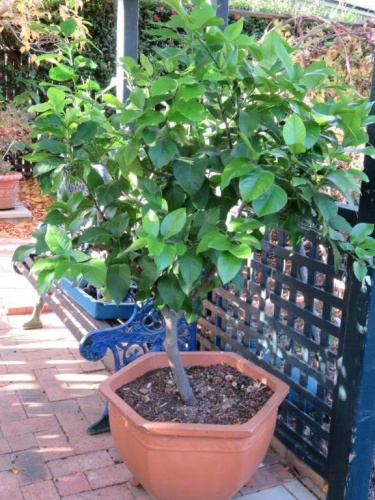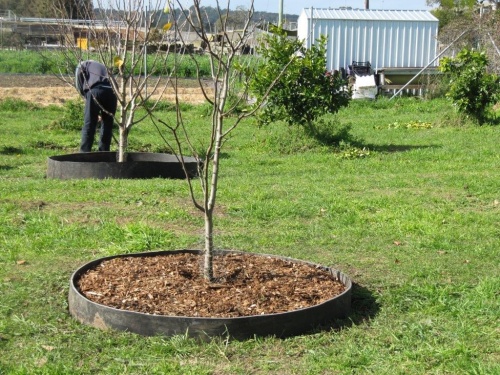
BUT for oranges, citrus trees, such as lemons, limes, kumquats and grapefruit, all grow well in our region.
Typically, oranges need the long, hot summers of the Riverina to sweeten properly, but there are always exceptions and some readers tell me they have a wonderful crop.

Possibly the best place to plant citrus is against a north-facing wall, particularly if the house is brick, which will provide added heat.
This was the traditional place to plant lemons in the early days of Canberra when every government home had a brick chimney and a Rayburn wood heater. The bricks in the chimney would heat up in the evening and stay warm during the night keeping frost from the lemon tree.
So, where is the home of citrus? Seville in Spain immediately comes to mind. Actually citrus arrived there many hundreds of years ago from China introduced by the Arabs. The Romans, through their trade with India, had well-established orange groves certainly by the 4th century AD.
Citrus had been cultivated by the Chinese since at least 1000 BC.
Han Yanzhi writing in the first book of any language devoted specifically to citrus in 1178 mentions at least 28 kinds of citrus. Mandarins, sweet and sour oranges, pomelos and kumquats were all mentioned, together with his instructions for planting, cultivation, manuring, irrigation, grafting, storage and medicinal uses.
Citrus trees have been grown in containers for hundreds of years with elaborate orangeries still to be seen at such places as the Palace of Versailles. The huge potted terracotta containers were brought into these places in winter and moved outside in summer. Fortunately, we do not have to do this here and, except for newly planted trees, we don’t have to protect them from our mild frosts. Container-grown citrus are ideal on a sunny balcony.
- They should be no smaller than 40cm diameter across the top and preferably 50cm.
- Always use premium potting mix.
- It’s not necessary to place gravel or similar in the bottom of the pot, just a few broken tiles over the holes.
- Don’t use a saucer under the container as this encourages root rot. Raise the container off the ground with either specific pot feet or broken bricks.
Growing in the ground requires good preparation:
- If the soil is heavy clay, as it mostly is here, it is not necessary to dig a huge hole. The ground may be so solid it may be impossible to do so. In this case simply loosen the soil on the top 10-20cm then apply Multicrop Liquid Ground Breaker, which will gradually break down the clay particles, soaking down and sideways. This is much more effective than gypsum.
- Before taking the citrus tree out of the container, give it a good soaking with added liquid seaweed plant nutrient. The fine roots tend to stick to the inside of the plastic pot. By this watering it will enable the plant to slide out of the pot, reducing root damage.
- Gently lift the plant out of the container and place in the hole. Fill in the space around the plant, firming as you go and water thoroughly to eliminate air pockets. Then make a soil mound around the tree to hold at least a nine-litre bucket of water for deep, summer watering.

- With substantial spring growth on fruit trees, they can be pruned this month, especially if a winter pruning was missed.
- Fruit crop can be reduced by up to 30 per cent if weeds and grass aren’t kept from growing back to the drip line under fruit trees.
- Plant rue and marigolds around the veggie patch to control insects.
- Place a section of plastic agricultural drain pipe down the centre of the potting mix if growing strawberries in a container. It acts as an air vent keeping the soil sweeter and gets liquid seaweed plant food to the roots more effectively.
Who can be trusted?
In a world of spin and confusion, there’s never been a more important time to support independent journalism in Canberra.
If you trust our work online and want to enforce the power of independent voices, I invite you to make a small contribution.
Every dollar of support is invested back into our journalism to help keep citynews.com.au strong and free.
Thank you,
Ian Meikle, editor



![Evie Hudson is a woman with amnesia, who forgets the last 13 years. Piecing her life back together, she navigates the harsh realities of coercive control.
Evie is the leading character in local author @emmagreyauthor's second novel Pictures of You.
Her debut book, The Last Love Note, sold more than 100,000 books worldwide within a few months of being published last year.
“I think that using amnesia really helped [show the effects of coercive control] because she had that sense of being completely lost in her own life,” Emma says of her new work of fiction.
To read the full story and find out more about this fabulous local author and her latest novel, visit our website at citynews.com.au or click the link in our bio! 📚✒️
#canberra #local #canberralocals #canberralife #australia #author #localauthor #Picturesofyou #coercivecontrolisabuse #dvawareness #bestsellingauthor #canberraauthor #localnews #citynews](https://citynews.com.au/wp-content/plugins/instagram-feed/img/placeholder.png)
Leave a Reply